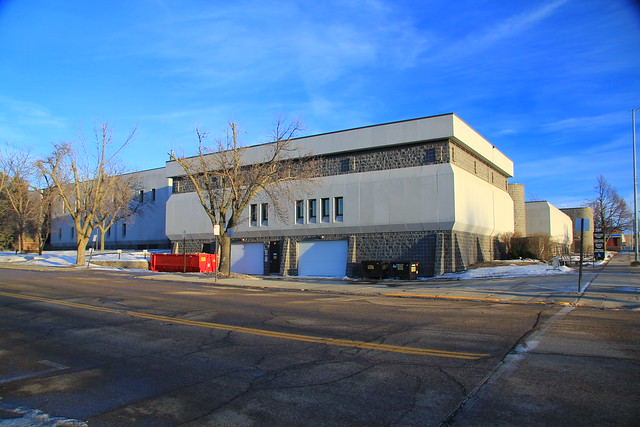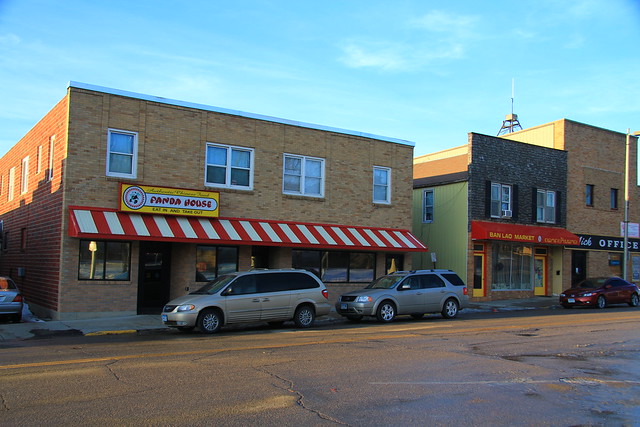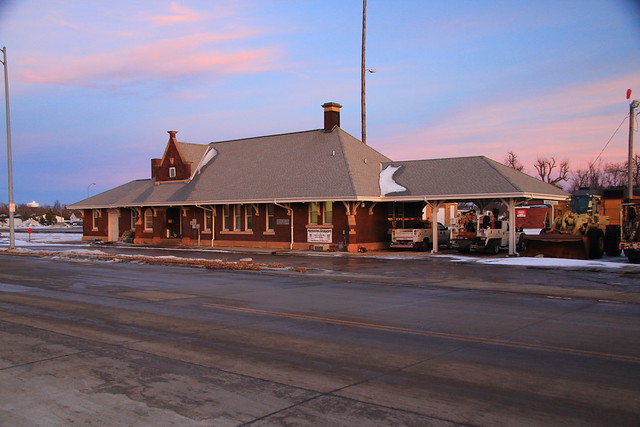 |
| Tesla Motors' Supercharger network as of March 2014. |
Tesla Motors has been building up a national network of Supercharger stations for their Model S electric vehicle over the past year and a half. They first built stations in California, then stretched networks north and south along the East and West Coasts, and have just recently finished a transcontinental string of stations from southern California to New York. Rather than taking a straight shot, the string of stations wends northward through scenic western locales such as Moab, Utah, climbs through the Rocky Mountains, and then goes north to I-90 in around the Wyoming–South Dakota border, within distance of Mount Rushmore.
It's about 800 miles longer than a straight shot between Los Angeles and New York. But lucky for any Minnesotans who own the Model S, our state received two Supercharger stops along I-90, in Worthington and Albert Lea, and there are a few others just across the border in South Dakota and Wisconsin.
One of the goals of Tesla's founders has been to create a practical electric car to help us get off of carbon-laden fossil fuels. Tesla has taken a unique approach to making the electric car practical, something that's still a work in progress despite some huge achievements already.
Most entrepreneurial efforts into the electric-car market have been built around low-end vehicles that weren't even classified as regular cars because they were limited to low speeds or only had three wheels, but still ended up costing as much as a decent small car. Bigger automakers have struggled with finding the right vehicles to convert to electric operation, or to design entirely as electric vehicles. Entry-level cars fitted with electric drivetrains end up reaching mid-market or even upmarket prices, though the absolute costs have started to come down as sales of the most popular models have reached into the tens of thousands.
Tesla's approach has been to start out at a higher price point, where the additional cost of specialized electronics and the bulky battery pack is a lower percentage of the overall cost. For their first car, the Roadster, they aimed at two killer features: A driving range of more than 200 miles, and a level of acceleration that competes with the fastest vehicles on the road. But it was a cramped two-seater with limited storage space—a fun, sporty vehicle, but not quite a daily driver.
The current Model S car is much more well-rounded. The all-electric drivetrain allowed designers to try new things because the big lump of an engine wasn't in front anymore. In addition to offering a range of more than 250 miles per charge and still having tremendous performance, it is a larger 5-door sedan, optionally seating up to 7 passengers if the two rear-facing seats for children are included. It has won numerous awards, including matching the best score Consumer Reports has ever given for a car. The battery pack is slung low under the car in a "skateboard" arrangement, making the vehicle have an extremely low center of gravity—it's very difficult to get the car to roll over.
So, for people who can afford it, Tesla has a compelling offering. Travel by car has by far the largest mode share in the country today, and it's in all of our best interests to make sure that cars and trucks become as energy-efficient as possible. The company is doing a good job of breaking down the barriers that have held people back from buying electric vehicles in the past. But a couple of things keep me up at night: First, will Tesla or other electric-vehicle manufacturers ever be able to reach a price point that makes them broadly popular? Second, how far can we really get by converting cars to run on electricity? (Hydrogen- and methane-powered vehicles will also probably have some role to play.)
The answer to the second question is pretty clear—even if our entire vehicle fleet suddenly became much more efficient, it wouldn't be enough to meet our carbon-reduction goals. We also need to change our land use patterns. I'm a big believer in using the tools of good urbanism to provide walkable and bikeable environments, and linking neighborhoods and cities with quality public transit networks using a mix of buses and trains. Even with that, we will probably need to find ways to effectively run our whole petroleum production process in reverse, pulling CO2 out of the atmosphere and sequestering it underground in some form (in my mind, liquid is safer than the gaseous storage methods that have been proposed).
So, to circle around to the Supercharger stations again, I have to say that I'm almost wholly unimpressed with the places where these stations have been going in. While Superchargers offer the ability to recharge a Tesla vehicle very quickly (adding 200 miles of range to an empty battery in under 40 minutes), they're usually located in suburban-style strips or the fringes of shopping mall parking lots.
Here's the one in Albert Lea, four stalls in the parking lot of an AmericInn hotel just off I-90 (the first exit west of I-35). If you're going to be waiting for your car to charge for 20 to 40 minutes, it would seem ideal to use that time to shop or grab a bite to eat. But the nearest food here is at Burger King, and it's not a very walkable environment (no sidewalks):

Here's the one in Worthington, six stalls in the parking lot of a Ground Round restaurant. There was one couple there sitting in their car waiting for it to charge, also in a sidewalkless suburban-style sprawl zone:

Of course, the Supercharger stations are located close to the highway, much like many regular filling stations. Sometimes they're in the parking lots of restaurants, sometimes hotels. But in most cases, the stations are located only a couple of minutes away from nice, walkable central business districts.
One of the thing that frustrates me most about driving by car these days is the sameness that's found wherever you stop. Mostly the same fast-food joints, with only faint whiffs of what makes a place unique.
On my January trek out to visit the stations, I decided to stop in downtown Worthington (I skipped central Albert Lea, though there is a streets.mn writeup on that Main Street already).
Worthington has a decent central business district, a variety of 1- to 3-story buildings:

There were a number of Mexican and Asian restaurants and shops. I never would have guessed. I couldn't quite figure out the language of this sign:

It isn't all traditional buildings. As in countless other cities, it was clear that a portion of the town center had been torn down, in this case to make way for a fortresslike government center:

Some of the restaurants:

And, for good measure, the former train station, still used as offices by Union Pacific. Perhaps someday in my lifetime, they'll use it again for passenger trains.

So if you were setting up stopping points for a cross-country adventure, which would you pick? I'm a fan of the walkable downtown—even in this small community, there was plenty to see in a short distance of the free downtown parking lot. Placing chargers in town centers would help reinforce those communities by bringing travelers to see something they wouldn't quite expect otherwise, alleviating the blandness of the highway.
While I'm not a fan of their charger locations, it won't impact me for a while. If and until I need to get a new car, and I turn out to be able to afford one of their next-generation vehicles, charging locations remain a question for Tesla and their existing customer base. Do their customers want to be stuck in their cars in unwalkable suburban landscapes while they wait to charge up, or will they demand something better?
Perhaps non-Tesla charging stations will take a hint and be placed in better locations, though that almost becomes a requirement for other vehicles. Most electric cars on the road in the U.S. today only take current from slower Level 1 or Level 2 chargers (basically 120- or 240-volt power), and take several hours to fully charge. Topping off doesn't take as long, but still, if you're going to be stuck in one place for a while, public chargers pretty much need to be in walkable locations.
I'm not sure if I'll ever get a pure electric car. I'm an apartment dweller, which will make charging at home difficult for the foreseeable future. I'll need some sort of fast public charging infrastructure, unless my building management decides to take the initiative and set something up themselves. Most existing electrics also only offer driving range of roughly 80-100 miles (sometimes only half that). I have a recurring need to drive 80-100 miles on relatively short notice, so I'll either need something with a bigger battery or a growth in the availability of fast-charging infrastructure.
Tesla's Supercharger network isn't quite going to work either, at least for now—they're currently Tesla-specific proprietary technology, not offered on any other vehicles. But even if another manufacturer licensed the necessary pieces, batteries would need to grow as well. Those chargers in Worthington and Albert Lea are 114 miles apart, farther than virtually any non-Tesla electric vehicle can go today. There is an emerging nationwide standard for fast-charging which should help cars with smaller batteries, but the chargers aren't yet widely deployed, and very few cars have been built with the appropriate on-board connector.
It's both amazing and disheartening to see how far electric vehicles have come in the last decade. Huge leaps forward have been made, but with many more still left to go.